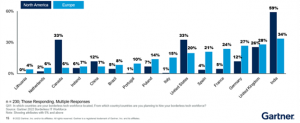Is a Borderless Workforce a Run Around the H1B Shortage?
Although I’ve worked remotely for decades, companies “discovered” that remote workers are indeed productive when the global pandemic hit. A Gartner, Inc survey finds 58% of organizations are using borderless technology talent. Borderless hiring is the use of talent globally without geographical constraints. This practice has just about doubled in the past three years due to difficulties finding workers and, of course, the pandemic’s impact. The trend is far from slowing down, as the survey indicates 27% of leaders are exploring borderless tech employees.
 Figure 1. Borderless Tech Force Locations by Country
Figure 1. Borderless Tech Force Locations by Country
Jobs such as IT, design, advertising, data analysis, engineers, and developers, are gaining borderless traction—even from workers in war-torn Ukraine. The survey found that, in organizations that use borderless talent, 19% of their IT workforce is borderless.
The top two areas of expertise are software engineering/application development (62% of survey respondents) and application support (55% of survey respondents). 71% of surveyed organizations said it is critical to factor in the specific needs of borderless tech workers in their workplace strategy, and 50% of organizations said they have fully implemented tools related to collaboration and productivity, such as cloud office suites, workstream collaboration, meeting solutions, and digital whiteboarding.
India is the most selected country for recruiting borderless technology labor for European and North American companies; the U.K. ranks fourth place, Europe (28%), and North America (26%). The survey also found that Europe has a significant concentration of hiring inside its borders since Europe has favorable labor laws for hiring borderless staff.
The survey was conducted among 288 C-level executives and their direct reports during the second quarter of 2022 to understand their willingness to pursue a borderless tech workforce, their plans, and the adoption of a borderless workforce.
So, to answer the question, no. Borderless hiring is likely not a complete run around H1B visas. However, as the increase in H1B stalls, there’s a definite correlation. Ultimately where the “run around” can be seen is in jobs not going to U.S. citizens. Since there is a labor shortage, the impact of borderless jobs wanted by U.S. employees is not substantial. However, given the CHIPS Act and the funds going to STEM and training, I wonder when if a clash will occur in a few years.
Access the report: “Survey Results: CIOs Solve the Talent and Skills Shortage by Hiring Borderless Workers.”

